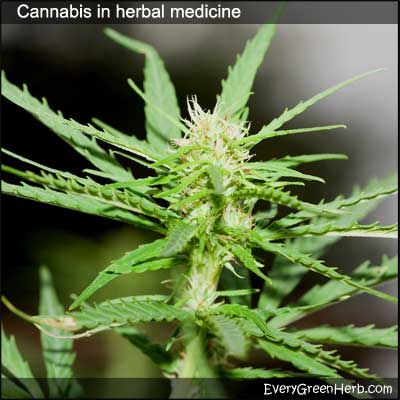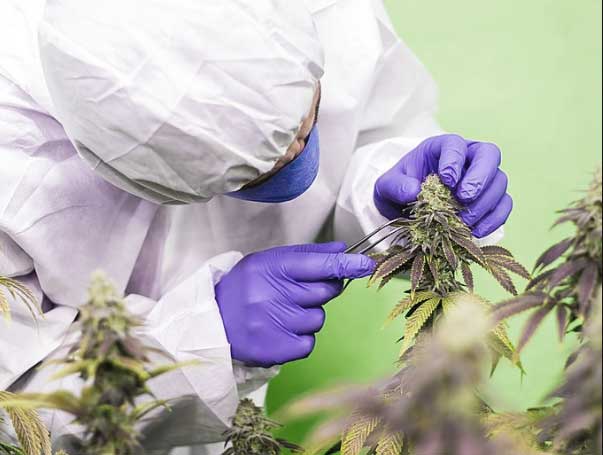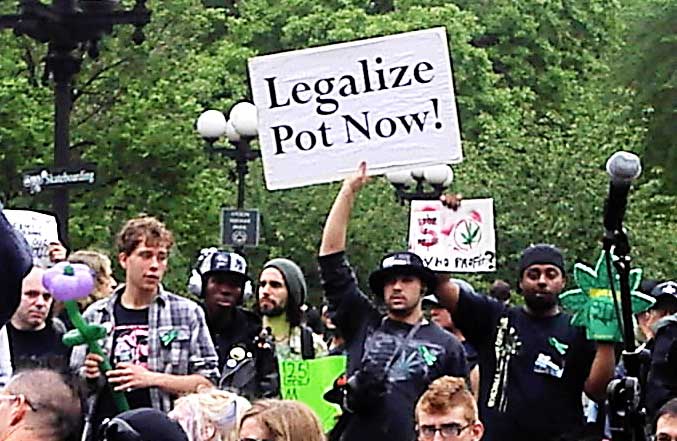Cannabis in herbal medicine
Cannabis (Cannabis sativa, Cannabis indica) is smoked like tobacco, vaporized, baked into cookies, juiced, powdered, used in oral sprays, added to herbal lotions, infused into oils, and made into liquid extracts.

Cannabis edibles like marijuana brownies and snack bars are becoming more commonplace as laws and attitudes change. When smoked, cannabis produces a distinct aroma and has a unique flavor. Strength varies depending on variety and production techniques.
Cannabis is a natural pain killer.
According to recent studies, marijuana should be the first-line-treatment for patients with pain.
Marijuana has the ability to alleviate neuropathic pain, a notoriously difficult-to-treat type of nerve pain associated with cancer, diabetes, HIV/AIDS, spinal cord injury, and many other debilitating conditions.
Research shows that cannabis consistently reduces pain levels to a degree that is as good or better than currently available medications. Unlike dangerous prescription pain-killers which are highly addictive, cannabis is unlikely to cause addiction or overdose.
Headache pain, chronic back pain, pain from various cancers, pain from glaucoma, and pain stemming from neurological problems are the most common reasons that people ask their healthcare professionals to write prescriptions for medical marijuana. Learn more about treating pain with herbs.

Does all cannabis get you high?
No. The high you get from consuming cannabis comes from THC (tetrahydrocannabinol) also known as Delta 9. The more THC you consume, the higher you get. Some cannabis products contain little or no THC so you don't get any psychoactive effects at all.
Psychoactive properties in THC bring about feelings of euphoria, mental excitement, and physical well-being. They can also cause paranoia and other unpleasant sensations like dry mouth in some people.
Cannabis is one medicinal herb that is not often used in tea form. THC is not water soluble, but does dissolve in alcohol and in oil.
Cannabis, occasionally sold in tincture and oil forms, is more often smoked in a "joint". Gummies are also popular and seem to work great as a natural remedy for people with lung problems.

What kind of cannabis should I buy?
Terminology can be confusing. Cannabis, hemp, marijuana, CBD oil, flowers, tinctures, THC levels, terpenes, various isolates, fancy names, and branding can make it hard to choose what to buy.
If you want to get high, you will want a product that you take internally and contains over .03% of THC which is the legal limit in many states. Look for products containing 5 - 30% THC and you will get the euphoria you expect. These products are only available where medical and/or recreational marijuana is legal.
If you don't want to get high, then products with less than .03% THC will work. If you want relief from joint pain and aching muscles, then a CBD lotion or ointment with < .03% is fine. Horrible migraines? Then you might require something stronger. It depends on your needs.
Skip down a few sections to find more information on the differences between sativa and indica. Both of these cannabis species, which contain THC, have different properties and uses in herbal medicine.
Down with Delta 8
As new isolates are discovered, things get more confusing. A new product called Delta 8 is currently on the market. Since it is legal due to loop-holes in the laws, some people are choosing to use it. Reviews are mixed.
Delta 8 gives a slight feeling of euphoria, but doesn't last as long as cannabis that contains (Delta 9) THC. Many people sing the praises of these new strains of cannabis, but others consider them a waste of money.
Although Delta 8 looks and smells like a potent "cannabis flower bud", these products are sure to disappoint anyone that has ever consumed Delta 9.

Buyers beware
Delta 8, hemp, and other forms of cannabis are often sold on the black market as Delta 9. These buds are often sprayed with chemicals or have been previously vaped (which removes most of the THC). You really don't know what you are getting when you purchase from street dealers and unregulated dispensaries.
Studies also show that some legal cannabis products contain amounts that differ greatly from what is printed on the labels. Even many legal products are worthless when it comes to healing and herbal medicine.
Cannabis is illegal in many parts of the United States.
Incorrectly ranked by governmental agencies, cannabis with enough THC to get you high, is officially put into the same category as heroin and LSD. Although attitudes and laws are changing, this useful medicinal herb is still outlawed in most of the world.
Cannabis has many uses.
People use cannabis for treating Parkinson's disease, muscle spasms, multiple sclerosis, nausea resulting from chemotherapy, and poor appetite caused by chronic illnesses such as HIV.
Cannabis shows promise in the treatment of Huntington's disease, bipolar disorder, anorexia, Alzheimer's, dementia, depression, chronic stress, insomnia, PMS, asthma, eye problems, age related diseases, and some digestive diseases. It can also help stop seizures.
Scientific studies
Research shows that cannabis is useful in treating pain associated with nerve injury. Cannabis use also reduces prescription drug abuse and addiction to opiates.
It is proven that cannabis is not a gateway drug, and does not lead to meth or heroin use. In places where marijuana is illegal, the black market and unsavory elements might introduce a person to hard drugs and other criminal activities, but it is not the cannabis that does it. Environment, circumstances, and genetics are responsible for leading a person to drug addiction, not cannabis.
Cannabinoids such as CBD are effective in the treatment of seizures associated with epilepsy.
Cannabis is also good for lowering eye pressure in people with glaucoma although effects only last a short period of time.
It is also useful in the treatment of HIV/AIDS and eating disorders where it helps increase appetite.
Cannabis is also shown to significantly improve the tic severity in people with Tourette syndrome.
It can also help people with multiple sclerosis, people undergoing chemotherapy treatments, people suffering from post-traumatic stress disorder, and sleep problems.
Cannabis helps the body's natural chemicals work better.
Scientists have proven that cannabis really is a healing herb. It gets pretty technical reading about neuron sensors and brain receptors, but the research is solid. Cannabis is an effective medicine.

Cannabis indica and cannabis sativa
The genus Cannabis contains two species which produce psychoactive cannabinoids (the stuff that makes you high). Cannabis indica and cannabis sativa both contain THC but the plants look different and are used for different purposes.
There are also a variety of very promising hybrids being developed to treat individual diseases. Cannabis indica, Cannabis sativa, and their various strains are all very useful in alternative medicine.
A third species, Cannabis ruderalis, has few psychogenic properties but is useful for making hemp rope, paper, and other products. It does not get you high.
When using medicinal cannabis, should you choose indica or sativa?
Indica is more suited for the treatment of pain and insomnia.
Look for indica strains if you want a relaxing, body high. This type of marijuana will stimulate the appetite, reduce pain, and help you sleep. Indica is used to relax the muscles and reduce nausea. It is best for nighttime use. The flavors in indica tend to be sweet like berries or candy.
Sativa is more suited for treating fatigue, depression, and attention disorders.
Look for sativa strains of cannabis if you want a head high and more energy. This type of marijuana will help you enjoy doing boring chores, it will increase creativity, help you to focus, reduce anxiety, and uplift the spirit. The flavors of sativa tend to be earthy.
Blends and all kinds of new marijuana strains that treat different problems are available at cannabis dispensaries in states where cannabis is legal.
More about cannabinoids
The most psychoactive cannabinoid found in the cannabis plant is tetrahydrocannabinol (THC). THC is what makes people high or stoned.
Cannabis contains hundreds of other known compounds and at least eighty of them interact with receptors in the brain. Cannabinoids are currently being studied by the U.S. FDA , other organizations, and private companies.
Most cannabinoids have been found to contain healing properties. Too bad cannabis is listed as a Schedule One medicinal plant in the US (along with heroin and cocaine) making it illegal to possess in many states.
Cannabis CBD oil
Usually made from hemp, CBD oil does not contain THC. It does not get you high, but it does offer great medicinal benefits. It is used in creams, lotions, tinctures, and other herbal products to treat pain and other ailments. It is also used to treat children that have seizures and is showing great results. Read more about making your own herbal products at home.
Marijuana (cannabis) is in the news a lot lately.
Things are very confusing! Is is legal to smoke marijuana? Has it been decriminalized in my state? Is pot legal for recreational use by adults? Is hemp the same thing as cannabis? Is it legal to grow and purchase cannabis? Is CBD oil legal?
Lots of questions about marijuana
Where does your state stand in the cannabis prohibition debate? Marijuana legalization including recreational use has been adopted (either in part or in full) by voter initiatives in a number of US jurisdictions.
Colorado as the first to legalize marijuana for recreational use and will go into the history books!
As of October 2023, marijuana is available for medicinal use in over thirty states. That is great news. Many patients in most areas can finally get relief from pain and other symptoms of disease by using cannabis.
Many states even permit recreational use! It seems unfair that some places still consider using marijuana to be a crime.
In many states, even life-saving medicinal cannabis is frowned upon and will get you a jail sentence if caught. Medical grade cannabis is hard to get, causing patients to turn to the black market.
Please contact your local government representatives and get them to vote yes, at least to medical marijuana.

Marijuana has been decriminalized in many states.
Many people are hoping that marijuana prohibition will soon be a thing of the past. They point out that cannabis is an herbal medicine, not a dangerous drug.
Other people, such as big drug companies, some law enforcement agencies, and drug cartels, lobby hard to keep marijuana illegal. Even with all the resistance, things are changing as more and more Americans support the use of cannabis. Where do you stand on this issue?

Cannabis is wrongly classified.
The Schedule One classification of cannabis puts the herb right up there with heroin and LSD. This makes the study of medical cannabis difficult. It also causes users and providers of the herb to be branded as criminals.
The DEA (Drug Enforcement Administration) provides a list of different schedule categories and examples of drugs that are in each.
What if I smoke or ingest too much cannabis?
When you get too high on THC, you will feel paranoid or maybe even have a panic attack. Try splashing cool water on your face or taking a warm shower.
Relax with a cup of chamomile tea. Eat a snack that contains black pepper. Go for a walk or distract yourself by watching a movie.
Don't stress out. It will pass in a few hours. Remember than no one has ever overdosed on marijuana.
First time cannabis users should always start slowly. As with all medicinal herbs, use common sense, start with small doses, and remember that everyone is different.
Cannabis has been used as a medicinal herb for thousands of years.
The Cannabis plant has a history of medicinal use dating back thousands of years and across many cultures. Since ancient humans used hemp seed as food, it was quite natural for them to also discover that the plant contained medicinal properties.
Ancient Egyptian scrolls from 1550 B.C. mention medical cannabis. The writings describe adding cannabis to suppositories for relieving the pain of hemorrhoids. In ancient India, cannabis was used for treating insomnia, headaches, gastrointestinal disorders, and pain.
The Ancient Greeks used cannabis leaves to treat nose bleeds and cannabis seeds to expel tapeworms. In the medieval Islamic world, physicians used cannabis to treat edema, epilepsy, inflammation, and pain.
Cannabis in Chinese medicine
Even though it is illegal in China, cannabis is still listed as one of the 50 fundamental herbs in traditional Chinese medicine. The Chinese use cannabis as a herbal remedy for many conditions including constipation, gout, rheumatism, and absent-mindedness.

Cannabis plants
Cannabis is an easy to grow, annual, flowering plant that bears both male and female flowers that are pollinated by the wind.
Cannabis prefers full sun and rich soil but will grow in almost any garden. Check local laws before growing your own.
*Children and teenagers should never smoke cannabis or take any product containing THC. In many states, it is still illegal to grow cannabis, use cannabis, sell cannabis, or transport it across state lines.
For more information about marijuana laws in your state, see http://norml.org and click on state info.
Sources:
https://www.nccih.nih.gov/health/cannabis-marijuana-and-cannabinoids-what-you-need-to-know
https://www.ncbi.nlm.nih.gov/books/NBK425767/
https://en.wikipedia.org/wiki/Glossary_of_cannabis_terms
Blessings to you and yours!
Thanks so much for reading my blog. Jan.

*Note - the information on this website has not been evaluated by the Food and Drug Administration.
© 2005-2024 website design and content by Janice Boling